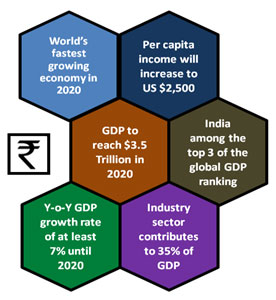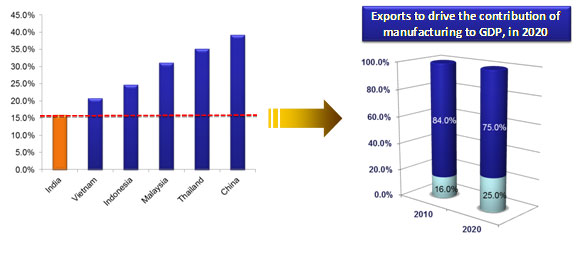| |
|
|
|
|
|
| Since 1991, India has undertaken far-reaching economic reforms of deregulation and liberalization, which has allowed the economy to become the third largest in Asia after China and Japan. India has gradually opened up its markets through economic reforms by reducing government controls on foreign trade and investment. |
|
|
| |
|
GDP Growth
India's GDP had been witnessing consistent growth rates in excess of 9 percent until 2007. The subprime crisis of the US in 2008 had a ripple effect on the Indian economy in 2008 resulting in slowing down of the GDP growth. However, India continues to remain one of the high growth economies and its GDP is expected to deliver consistent growth in this decade. Currently, the world's 10th
largest with a nominal GDP of 1.877 trillion USD in 2013, India is expected to surpass China as the world's fastest growing economy by 2018 and become a $3.5 trillion economy by 2020. The country's GDP growth is expected to remain at 6 percent or more on a year-to-year basis in the current decade. Chart 5.1.1.a below shows the growth trends in Indian GDP.
|
Chart 5.1.1.a
India: GDP Growth (2010-2020)
|
 |
|
Man Power
Being the second largest populous country, India has strived over the years to raise the level of literacy in the country. The nation announced this year it’s much awaited law on free and compulsory education to all children.
India’s education system is amongst the best in developing countries. India is home to nearly 1670 engineering colleges that produce more than 6.5 lakh engineers a day. India thus has sufficient technical skill set to meet the requirements in the electronics industry. As per the latest report from World Bank, India ranks 89 among 178 countries in its relative ease of employing workers.
Manufacturing in India
Landscape of the Indian Manufacturing Sector
Indian manufacturing has grown at a robust rate in the past decade and positioned the country as one of the best performing manufacturing economies. Manufacturing sector contributes to about 15 percent of the GDP, accounts for 50 percent of exports and provides employment to nearly 12 percent of the national labor force.
Manufacturing exports are expected to surge over $300 billion by 2020 thus amounting to 3.5 percent of the global share. And with the increase in manufacturing in the country, employment generation is also expected to see a boost with the creation of over 35 million jobs by the end of this decade. Chart 5.1.1.b shows the trend in manufacturing contribution to GDP.
Chart 5.1.1.b
India: Trend in Manufacturing Contribution to GDP
 |
|
|
| |
|
|
|